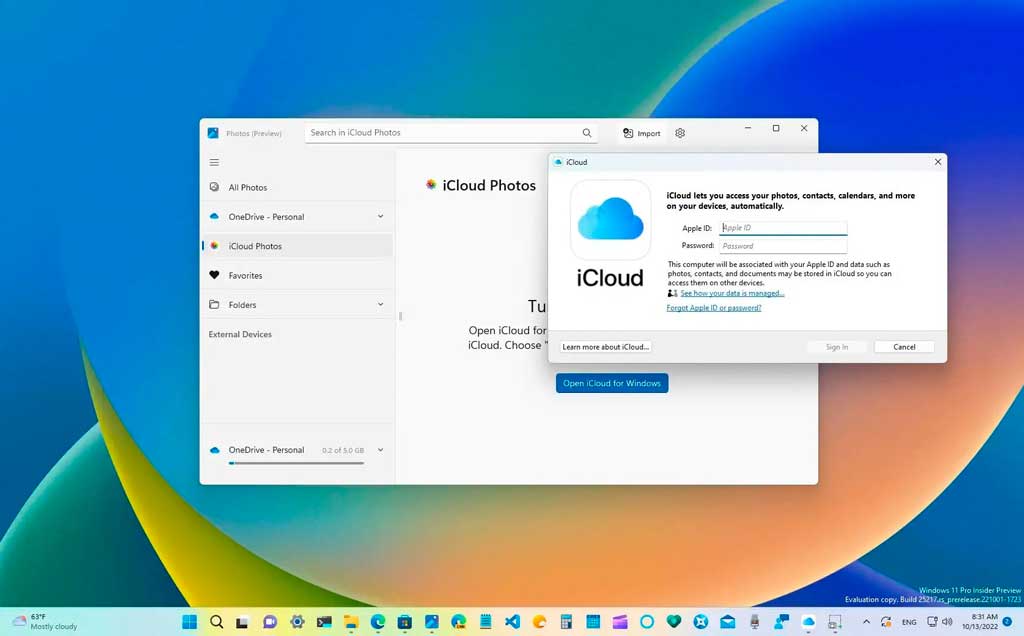
Although iCloud is born for Apple devices, it can also be integrated into computers with Windows. This article explains how to do it and describes its benefits.
How to set up iCloud on your Windows PC
Although iCloud is born for Apple devices, it can also be integrated into computers with Windows. The installation of iCloud on Windows It is an intuitive and simple process. To get started, download the app iCloud from the Microsoft Store and install it on your PC with Windows. It is essential that your operating system is 64 bits.
- Download and Install: Go to the Microsoft Store, search for “iCloud,” and click “Get” to start the download.
- Initial setup: Once installed, open the application, logging in with your Apple ID existing or creating a new account if necessary.
If you are using a version of Windows older than Windows 10, you can download the installer directly from the official site. Apple .
First steps with iCloud in a Windows environment
When you open iCloud, you will be prompted to Sign in with your Apple ID. Make sure you use the same account that you use on your other Apple devices. After you sign in, you'll see a list of iCloud services that you can sync with your PC. Select the items you want to sync and press "Apply."
The iCloud icon will appear on the Windows taskbar, allowing you to quickly access iCloud folders and settings.
Another way to access iCloud on Windows is through its official website iCloud.com. Use your favorite web browser, visit iCloud.com and use your Apple ID to access your files and apps directly from the browser.

iCloud features on Windows
File without borders: iCloud and Windows in sync
iCloud allows you to keep your files in sync between your Apple devices and your PC. When you upload a file to iCloud Drive from your PC, it will automatically sync with all your devices, allowing you to access them from anywhere.
- Access to files from Windows Explorer.
- Automatic synchronization of new and modified files.
- File management directly from your PC.
Your gallery in the cloud: Photos always with you
iCloud Photo Library allows you to have all your photos accessible from your PC. When you upload photos from your computer, they will automatically sync with your iPhone, iPad, and other Apple devices.
- Access to all your photos from the iCloud Photos folder.
- Automatic upload of new photos to the cloud.
- Synchronization of albums shared with friends and family.
Bookmarks at hand: Bookmarks between Safari and Windows
iCloud lets you sync your web browser's bookmarks with Safari on your Apple devices. This ensures that your favorite sites are always accessible, no matter what device you're using.
- Synchronization with Internet Explorer, Chrome and Firefox.
- Access your bookmarks from Safari on iPhone and iPad.
- Easy management of your favorite sites.
Email and contacts always updated
With iCloud for Windows, you can keep your emails, contacts, and calendars in sync with the native Windows Mail app. This makes it easier to manage your correspondence and agenda, ensuring you don't miss any important details.
- Synchronization with the Windows Mail application.
- Access to your iCloud contacts and calendars.
- Management of tasks and events from your PC.

Free space, simple life: Cleaning iCloud backups
iCloud also allows you to manage backups of your iOS devices. From the iCloud app on Windows, you can view and delete backups of apps you don't need, freeing up space in your iCloud account.
- Access to backups of your iOS devices.
- Elimination of unnecessary backups.
- iCloud storage management from your PC.
Discover iCloud+: Beyond storage
iCloud + is a premium subscription that significantly expands the functionalities of the base iCloud service.
PrivateRelay: Improve security by hiding your web browsing and protecting your personal data.
Email Hiding: Allows you to create and use temporary email addresses to protect your privacy.
Custom Email: Ability to personalize your email address with a domain of your choice.
HomeKit Secure Video: Save, analyze and view encrypted videos from HomeKit-compatible security cameras. The number of cameras supported depends on the iCloud+ plan.
Share with family: Share your iCloud+ subscription with up to five family members, making it easy to access premium storage and features.
iCloud+ pricing
| Plan | Price |
|---|---|
| 50 GB | € 0,99 per month |
| 200 GB | € 2,99 per month |
| 2 TB | € 9,99 per month |
Get detailed information about the pricing and features of each plan by visiting apple.com.
Requirements for an efficient iCloud in Windows
To use iCloud on Windows, you need a PC running Windows 10 or later. The app does not support managed Apple IDs, and some advanced features require specific versions of iCloud for Windows.
If you have activated the Advanced Data Protection, make sure you have iCloud for Windows version 14.1 or later. To use security keys, version 15 or later is required. See more details in the Apple Technical Support.
A solid and complete integration
iCloud integration with Windows gives you a complete solution for managing your data and files between devices. With easy setup and robust features, you can enjoy a smooth and consistent experience, no matter what device you're using.
Use iCloud on Windows allows you to have all your files and applications synchronized regardless of the device you work on. This flexibility is especially useful for those who use both Apple devices and Windows PCs. Whether you opt for the free version or subscribe to iCloud+, the integration is seamless and the functionality is extensive.
For additional support, Apple offers official technical support where you can resolve any questions about the installation and use of iCloud in Windows.
I am Sebastián Vidal, a computer engineer passionate about technology and DIY. Furthermore, I am the creator of tecnobits.com, where I share tutorials to make technology more accessible and understandable for everyone.